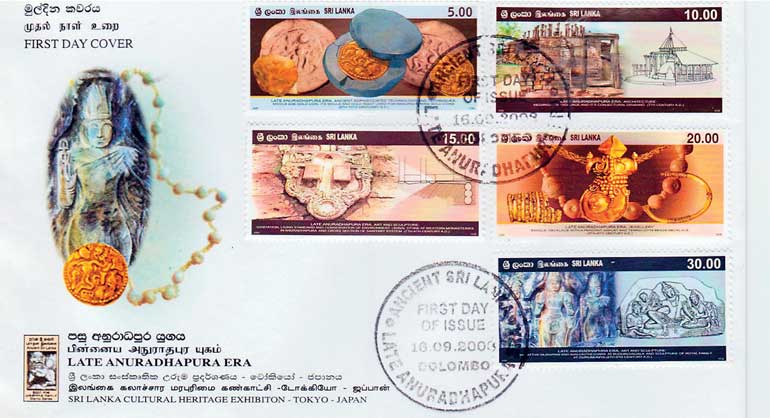Sunday Dec 07, 2025
Sunday Dec 07, 2025
Saturday, 9 April 2016 00:00 - - {{hitsCtrl.values.hits}}
 The late Anuradhapura period is observed as one of disarray due both to repeated South Indian invasions as well as internal squabbles leading to a weak administration. However, progress in areas like art and architecture, and irrigation are clearly visible especially during periods when there was peace. It is generally accepted that irrigation technology reached higher levels during this period.
The late Anuradhapura period is observed as one of disarray due both to repeated South Indian invasions as well as internal squabbles leading to a weak administration. However, progress in areas like art and architecture, and irrigation are clearly visible especially during periods when there was peace. It is generally accepted that irrigation technology reached higher levels during this period.
In the sphere of architecture, while the stupa maintained its place in Buddhist worship and many new ones were built, they were not as colossal as the ones constructed during the earlier period. At the same time the circular shrines (‘cetiyaghara’ or ‘vatda-ge’) which enclosed stupas of smaller size had their wooden pillars replaced in the 7th and 8th centuries by carved stone pillars surmounted by ornamental capitals. These shrines were built on an elevated circular dais. A flight of steps was used to go up to the shrine. Well-known examples of this type of shrine are he ‘vata-da-ges’ at Thuparama and Lankarama at Anuradhapura, and at Mihintale, Medirigiriya and Tiriyay.
The Rs. 10 stamp depicts the Medirigirya ‘vata-da-ge’ (7th century), arguably the most well-preserved shrine of this type seen today. The pillars have been arranged in four to two concentric circles, diminishing in size outwards. Describing its features, historian C.W. Nicholas says that the shafts are of slender and graceful proportions and the capitals which surmount them are a conventionalised lotus in basic form carved with figures of dwarfs, geese, lions and other motifs.
The illustration on the right shows an artist’s impression of the original ‘vata-da-ge’.
Art and sculpture also reached a high standard during this era. Moonstones (‘sandakapada pahan’) complete with elaborate carvings, guard stones (‘mura-gal’) and dwarf stones (‘korawakgal’) are creations of this period. High quality murals have also been found in a number of places including Pulligoda, Mahiyangana relic chamber, Maravidiya, Vessangiriya, Gonagpolla, Karambagala, Sigiriya caves and Situlpahuwa.
Bodhisatvas
In the late 7th and early 8th centuries, eminent Mahayana teachers such as Gunvanrman, Vajirabodhi and Anomavajra visited Sri Lanka and propagated the Mahayana doctrine. Mahayana influence is seen in the Bodhisatva cult being publicised with the erection of Bodhisatva statues at temple complexes and the inculcation of Bodhisatva veneration in the minds of the people.
Bodhisatva images constructed throughout the country ranged from mini metal statues to colossal stone images. Among these the ones at Buduruvagala rock (Rs. 30 stamp) are unique. The trio of Avalokitgheshvara, Maitriya and Vajrapani Bodhsisatvas are featured.
The well-executed piece of sculpture (right) presently displayed at the Isurumuniya museum has been identified as a royal family and depicts the Gupta style. Professor Senerat Paravitana has suggested that it could be prince Saliya and Asokamala in conversation with his father, King Dutugemnu and his mother.
Currency
Gold coins (Rs. 5 stamp) belonging to this era have been discovered during excavations at Abhayagiriya. These coins known as ‘ran kahavanu’ have been unearthed from the remnants of an old factory found when excavating a pond to the east of the monk’s alms hall near the ‘sanghavasa’ where the monks lived. Clay moulds used to make coins have also been found along with two lids and a tiny opening like a funnel to pour the melted gold.
It is believed that these had been used during the period between 8th and 11th centuries. A feature of these is the marking of the weight in Sinhala. However, a date of issue or a king’s name had not been marked.
There had been different sizes of the ‘ran kahavanu’. These had been termed ‘ada kahavanuwa’ meaning half a ‘kahavanu’, ‘palaya’ for a quarter and ‘aka’ for one eighth. Records indicate that the last named coin had been in use till about the 15th C CE.
The stamp features the coin, the mould and the gold ingot used to manufacture the coins.
Jewellery
Gold jewellery (Rs. 20 stamp) found at Abhayagiriya are a fine example of the expertise displayed in the manufacture of jewellery in that era. A bangle, a necklace with a pendant, an anklet a necklace with terracotta beads are featured in the stamp.
A whole lot of unfinished gold articles of a jewellery manufacturer had been found in a metal container in the shape of a mango at the Abhayagiri site. More items had also been discovered at the Jeravana site. These include jewellery with intricate carvings.
Sanitation
Much attention had been paid to health and sanitation as well as the living standards and the conservation of the environment. The Rs. 15 stamp features a carved urinal stone (‘kesikiligala’) belonging to the western monastery (‘Patanagara’ complex) for exclusive use by monks. Some scholars had interpreted the carvings on the urinal as a reminder that worldly possessions should be shunned or treated with contempt.
The pit of the urinal stone is formed by placing three large terracotta pots (illustrated on the right) placed on one on top of the other. The urine is filtered through stuff filled in the pots and ultimately drains into the soil as pure water. Urinals and latrines were separately maintained.
‘Jantagharas’ were built at monasteries providing hot water for the elderly and ailing monks to bathe. Grinding stones were provided to grind various medicinal items. Eco-friendly systems related to sanitary needs were in existence.
Next: Polonnaruwa Era